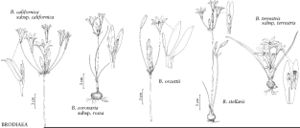Brodiaea
Trans. Linn. Soc. London 10: 2. 1811.
Herbs, perennial, scapose, from fibrous-coated corms. Leaves 1–6, basal; blade linear, crescent-shaped in cross-section. Scape solitary, cylindrical, usually slender, occasionally stout, rigid. Inflorescences umbellate, open, bracteate; bracts scarious, not enclosing flower buds. Flowers: perianth 6-tepaled, distinctly connate proximally into tube, shiny, abaxial perianth usually bluish purple, tube narrowly campanulate or funnelform, outer 3 lobes narrower than inner 3; stamens 3, epitepalous, opposite inner perianth lobes, alternating with 3 staminodia (staminodia absent in B. orcuttii) opposite outer perianth lobes; filaments adnate to perianth-tube, linear, base sometimes dilated to form triangular flap, or sometimes with abaxial wings or appendages; anthers basifixed, appressed to style; pistil 3-carpellate; ovary superior, green (purple in B. jolonensis), sessile, 3-locular, ovules several; style erect; stigma 3-lobed, lobes distinctly spreading and recurved; pedicel erect, articulate at base. Fruits capsular, ovoid, dehiscence loculicidal. Seeds black, rounded to flattened, coat with crust with longitudinal surface striations. x = 6, 8, 12, 16, 18, 20, or 24.
Distribution
w North America including Mexico (Baja California)
Discussion
Species 14 (14 in the flora).
Two schools of thought have existed regarding generic limits within the complex of species recognized under Brodiaea, Triteleia, and Dichelostemma: a single large genus (Brodiaea s.l.) with three subgenera (S. Watson 1879; W. L. Jepson 1923–1925; P. A. Munz 1959), or three separate genera (E. L. Greene 1886; R. F. Hoover 1939; G. Keator 1967, 1989, 1993; T. F. Niehaus 1971, 1980). Recent molecular, anatomical, and developmental evidence supports neither of these views. Bloomeria is related to Triteleia, and Brodiaea is closely related to Dichelostemma, with the only hexandrous species, D. capitatum, being sister to the rest of the three-staminate Brodiaea/Dichelostemma clade (R. Y. Berg 1978, 1996; J. C. Pires 2000). This recent evidence also suggests that the sections presently established within Brodiaea are in need of revision; thus a sectional classification is not utilized in this treatment (R. F. Hoover 1939b; T. F. Niehaus 1971; J. C. Pires 2000).
Polyploidy and ecological specialization to serpentine and other unique substrates is common in Brodiaea, resulting in several rare and endangered species. Eleven of the fourteen species are restricted to California, where the flowering date is highly dependent on the amount of moisture in the early spring. Several species are exceedingly variable. Corms of some species were eaten by native Americans.
Among the most important diagnostic characters within Brodiaea are features of the androecium, particularly the size and shape of the staminodia and apical filament appendages. These characters are easily seen with a hand lens in the field. When collecting flowering specimens, one should make a point of mounting a few dissected flowers in a manner that displays these critical characters.
Selected References
None.
Lower Taxa
Key
| 1 | Staminode apex subulate or cuspidate, or staminodia absent. | > 2 |
| 1 | Staminode apex rounded or notched (2-lobed in B. insignis). | > 4 |
| 2 | Staminodia absent. | Brodiaea orcuttii |
| 2 | Staminodia present. | > 3 |
| 3 | Staminode apex subulate; perianth tube splitting in fruit. | Brodiaea filifolia |
| 3 | Staminode apex cuspidate; perianth tube not splitting in fruit. | Brodiaea kinkiensis |
| 4 | Flowers 24–38 mm. | > 5 |
| 4 | Flowers 14–24(–33) mm. | > 8 |
| 5 | Staminodia narrowly linear, margins 1/4–1/2 involute; perianth tube splitting in fruit. | > 6 |
| 5 | Staminodia broad, margins mostly involute or planate; perianth tube not splitting in fruit. | > 7 |
| 6 | Filaments with 2 threadlike appendages at base; perianth lobes usually less than twice length of perianth tube; anthers obcordate, 3–6 mm. | Brodiaea appendiculata |
| 6 | Filaments without appendages at base, or appendages rudimentary; perianth lobes usually more than twice length of perianth tube; anthers linear, 9–12 mm. | Brodiaea californica |
| 7 | Perianth tube ovoid to narrowly campanulate; staminodia curving inward toward stamens overall but curving outward at apex, margins 3/4 involute. | Brodiaea coronaria |
| 7 | Perianth tube funnelform; staminodia erect or recurved distally, distant from stamens, margins planate or 1/4 involute. | Brodiaea elegans |
| 8 | Staminodia leaning inward, margins 1/4 involute, apex broad, hooded; perianth tube cylindrical or campanulate. | > 9 |
| 8 | Staminodia erect, margins 1/2–3/4 involute (1/4 involute in B. stellaris), apex notched (2-lobed in B. insignis); perianth tube usually urceolate, sometimes campanulate or narrowly cylindrical. | > 10 |
| 9 | Scape 0.5–20 cm; ovary green. | Brodiaea terrestris |
| 9 | Scape 6–15 cm; ovary light purple. | Brodiaea jolonensis |
| 10 | Filaments with 2 conspicuous, broad, white, abaxial appendages appearing as wings behind anthers. | Brodiaea stellaris |
| 10 | Filaments lacking broad white appendages, or appendages narrow and inconspicuous. | > 11 |
| 11 | Perianth tube not constricted above ovary; staminodia margins 3/4 involute. | Brodiaea insignis |
| 11 | Perianth tube slightly to strongly constricted above ovary, staminodia margins 1/2–3/4 involute. | > 12 |
| 12 | Anthers obcordate. | Brodiaea pallida |
| 12 | Anthers linear. | > 13 |
| 13 | Scape 2–10 cm; inner perianth lobes 5–7 mm wide; style 5–6 mm. | Brodiaea minor |
| 13 | Scape 10–25 cm; inner perianth lobes 4–5 mm wide; style 7–9 mm. | Brodiaea purdyi |
"broad" is not a number."narrower" is not a number."thicker" is not a number.
